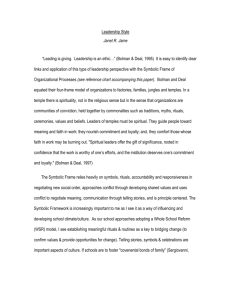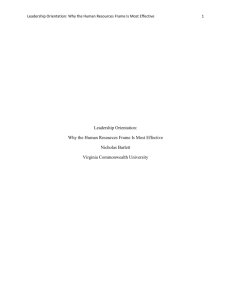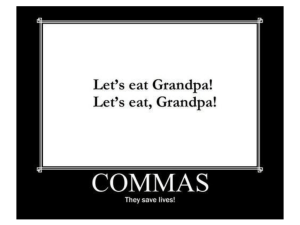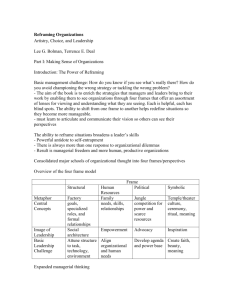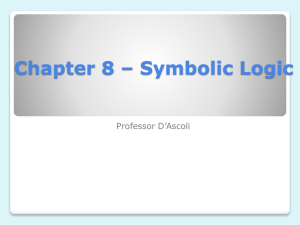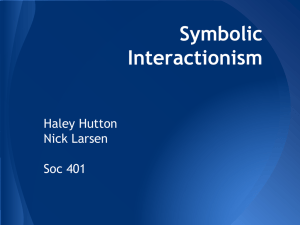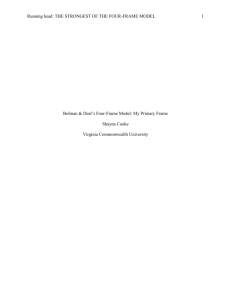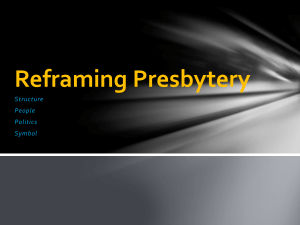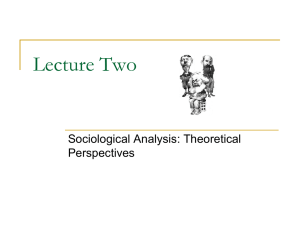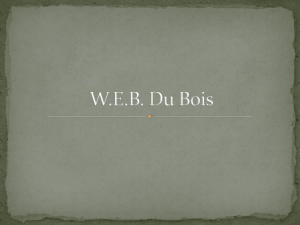Structural Human Resources Political Symbolic
advertisement
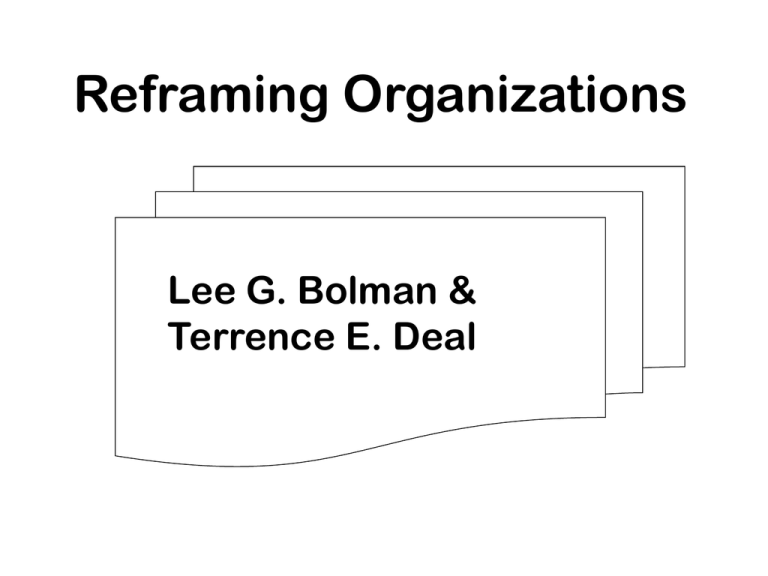
Reframing Organizations Lee G. Bolman & Terrence E. Deal Typical Organization Diagnosis • Blame the people – They are incompetent or have bad attitudes • Blame the bureaucracy – The rules are too stifling or there is a chaotic lack of roles and processes • Blame the thirst for power – People are only looking out for themselves These aren’t wrong they’re just an oversimplification Frames Lenses –focus, filter some things and allow others to pass through, help us order experience. Frames Tools –strengths and limitations. Wrong tool gets in the way; right tool makes the job easier. Structural Frame •From sociology and management science. •Emphasizes goals, specialized roles, and formal relationships. •Structures (Organization charts) fit organization’s environment and technology. •Responsibilities, rules, policies, procedures. Structural Tensions Differentiation (of roles/tasks) Integration (coordination of rules/products) – – – – Specialized roles/committees Rules and policies Authority or a “Coordinator” role Systems of control/coordination (meetings, committees, reporting lines, etc) Structural Frame Problems arise when the structure does not fit the situation. Time to restructure. Human Resource Frame •From psychology. •Organization as an extended family. •Individuals with needs, feelings, prejudices, skills, and limitations. •Capacity to learn—and capacity to defend old attitudes and belief. Human Resource Frame Challenge is to tailor organizations to people—find a way for individuals to get the job done while feeling good about what they are doing. Attending to People’s Needs • • • • Training and Development Belonging Mattering Esteem (both proud of selves and feel valued by others) • Self-actualization (reaching fullest potential) Political Frame •Rooted in political science. •Organizations as arenas, contests, or jungles. •Different interests competing for power/resources. •Rampant conflict— differences in needs, perspectives, and lifestyles. •Bargaining, negotiation, coercion, compromise, coalitions. Political Assumptions • Organizations are made of people and interest groups with their own goals/agendas • The most important decisions involve allocating scarce resources – who gets what? • Conflict is central to organization dynamics • Power is the most important asset • Decisions emerge from: bargaining, negotiation and jockeying for position, and have winners and losers. Political Resource Frame Problems arise when power is concentrated in the wrong places or is too broadly dispersed. Political skill •Know your sources of power. •Know everyone else’s sources of power and what they want. •Use informal communication. •Anticipate strategies others are likely to employ. Symbolic Frame Draws from social and cultural anthropology • Intentional shaping of organizational culture. Tools: • Story/Narrative • Heroes/Tales • Traditions/Rituals • Initiations/Ceremonies • Symbols • Use of Space • Metaphor Assumptions Symbolic Frame • What is important is not what happens, but what it means (what it is interpreted to mean) • Events have multiple meanings because people interpret experience differently. • Events and processes are more important for what is expressed than what is produced. • Culture (shared stories, traditions, symbols) are the glue that unites people around shared goals and values. Symbolic Frame Problems arise when actors play their parts badly, when symbols lose their meaning, when ceremonies and rituals lose their potency. Rebuild the expressive or spiritual side of organization through the use of symbols and stories. Reframing Organizations: A Review Match the theory or model with the frame. Abraham Maslow (1954)... defined the hierarchy of pre-potent needs 5 4 3 2 1 5. self-actualization 4. self-esteem 3. belongingness 2. safety, security 1. physiological Helgesen’s Web of Inclusion The term “web of inclusion” originally came from The Female Advantage. The women-led organizations I studied in that book were not standard hierarchies led from the top down. They were more circular in structure and were led from the center…. I believe that great companies will all operate as webs of inclusion in the future. Webs allow organizations to draw on the widest possible base of talent, a huge advantage in an economy based on knowledge. They allow resources to flow to where they’re needed. They undermine the tendency to become hierarchical. They put organizations more directly in touch with those they serve, and make partnerships easier to achieve. - Sally Helgesen Bolman and Deal’s Leading with Soul • Honor the past • Celebrate the present • Look to the future Theory X and Theory Y Mintzberg’s Five Configurations of Organizations • • • • • Simple Structure Machine Bureaucracy Professional Bureaucracy Divisionalised Form Adhocracy Niccolo Machiavelli • It is better to be feared than loved, if you cannot be both. • There is no avoiding war; it can only be postponed to the advantage of others. • Men rise from one ambition to another: first, they seek to secure themselves against attack, and then they attack others. • It is necessary for him who lays out a state and arranges laws for it to presuppose that all men are evil and that they are always going to act according to the wickedness of their spirits whenever they have free scope. Denning’s The Secret Language of Leadership In his exciting new book, The Secret Language of Leadership: How Leaders Inspire Action Through Narrative, (JosseyBass, October 2007), business narrative expert Steve Denning explains why traditional approaches to leadership communication don’t work and reveals the hidden patterns that effective leaders use to spark change. He shows how anyone can inspire enduring enthusiasm for a cause, even in skeptical, cynical or even hostile audiences and provides a comprehensive guide to the nitty-gritty of transformational leadership. Fisher and Ury’s, Getting to Yes Do not engage in positional bargaining – staking out a position and making relectant concessions. •Separate people from the problem •Focus on interests, not positions •Invent options for mutual gain •Insist on objective criteria – standards of fairness in substance and procedure •Create value for both parties Overview of the Four-Frame Model Frame Structural Human Resource Political Symbolic Metaphor for Organization Factory or Machine Family Jungle Carnival, temple, theater Central Concepts Rules, roles, goals, policies, technology, environment Needs, skills, relationships Power, conflict, competition, organizational politics Culture, meaning, metaphor, ritual, ceremony, stories, heroes Image of Leadership Social architecture Empowerment Advocacy Inspiration Basic Leadership Challenge Attune structure to task, technology, environment Align organizational and human needs Develop agenda and power base Create faith, beauty, meaning Organization al Ethic Excellence Caring Justice Faith Leadership Contribution Authorship Love Power Significance Source: Bolman & Deal (1997), p. 15 & p. 344 Reframing Organizations: A Review Identify your natural frame(s) IMPLICATIONS FOR LEADERSHIP Reframing Leadership Frame Structural Human Resources Political Symbolic Effective Leader Analyst, architect Catalyst, servant Advocate, negotiator Prophet, poet Effective Leadership Process Analysis, design Support, empowerment Advocacy, coalition building Inspiration, framing experience Ineffective Leader Petty tyrant Weakling, pushover Con artist, thug Fanatic, fool Ineffective Leadership Process Management by detail and fiat Abdication Manipulation, fraud Mirage, smoke & mirrors Source: Bolman & Deal (1997), p. 303 Effective Structural Leaders • Do their homework, they understand all aspects of the organization and how each affects the others • Understand the relationship of structure, strategy and environment • Focus on implementation, are ready to address resistance, training, and power grabs • Experiment, evaluate, and adapt Effective Human Resource Leaders • Believe in people and communicate their belief • Are visible and accessible • Empower others Effective Political Leaders • Clarify what they want and what they can get • Assess the distribution of power and interests • Build links among key stakeholders • Persuade first, negotiate second, and coerce only if necessary Effective Symbolic Leaders • • • • • • Lead by example Use symbols to capture attention Frame experience Communicate a vision Tell stories Respect and use history Chapter 16: A case study WHEN TO USE WHICH FRAME? Four Corners WHEN TO USE WHICH FRAME? Choosing a Frame Question Frame if answer is Yes Frame if answer is No Are individual commitment and motivation essential to success? Source: Bolman & Deal (2003), p. 310 Choosing a Frame Question Frame if answer is Yes Frame if answer is No Are individual commitment and motivation essential to success? Human Resource, Symbolic Structural, Political Is the technical quality of the decision important? Source: Bolman & Deal (2003), p. 310 Choosing a Frame Question Frame if answer is Yes Frame if answer is No Are individual commitment and motivation essential to success? Human Resource, Symbolic Structural, Political Is the technical quality of the decision important? Structural Human Resource, Political, Symbolic Are there high levels of ambiguity and uncertainty? Source: Bolman & Deal (2003), p. 310 Choosing a Frame Question Frame if answer is Yes Are individual commitment and motivation essential to success? Human Resource, Symbolic Structural, Political Is the technical quality of the decision important? Structural Are there high levels of Political, Symbolic ambiguity and uncertainty? Frame if answer is No Human Resource, Political, Symbolic Structural, Human Resource Are conflict and scarce resources significant? Source: Bolman & Deal (2003), p. 310 Choosing a Frame Question Frame if answer is Yes Frame if answer is No Are individual commitment and motivation essential to success? Human Resource, Symbolic Structural, Political Is the technical quality of the decision important? Structural Human Resource, Political, Symbolic Are there high levels of Political, Symbolic ambiguity and uncertainty? Structural, Human Resource Are conflict and scarce resources significant? Structural, Human Resource Political, Symbolic Are you working from the bottom up? Source: Bolman & Deal (2003), p. 310 Choosing a Frame Question Frame if answer is Yes Frame if answer is No Are individual commitment and motivation essential to success? Human Resource, Symbolic Structural, Political Is the technical quality of the decision important? Structural Human Resource, Political, Symbolic Are there high levels of Political, Symbolic ambiguity and uncertainty? Structural, Human Resource Are conflict and scarce resources significant? Political, Symbolic Structural, Human Resource Are you working from the bottom up? Political, Symbolic Structural, Human Resource Source: Bolman & Deal (2003), p. 310 Reframing Change Frame Structural Human Resources Political Symbolic Barriers to Change Loss of clarity and stability, confusion, chaos Anxiety, uncertainty, feelings of incompetence, neediness Disempowerment, conflict between winners and losers Loss of meaning and purpose, clinging to the past Essential Strategies Communicating, realigning and renegotiating formal patterns and policies Training to develop new skills, participation and involvement, psychological support Creating arenas where issues can be renegotiated and new coalitions formed Creating transition rituals: mourning the past, celebrating the future Source: Bolman & Deal (2003), p. 321 No one best way… Learn to work across and integrate frames. Organizations simultaneously have multiple true realities. Have awareness of your natural tendency. Use that strength Remind yourself to use other frames
